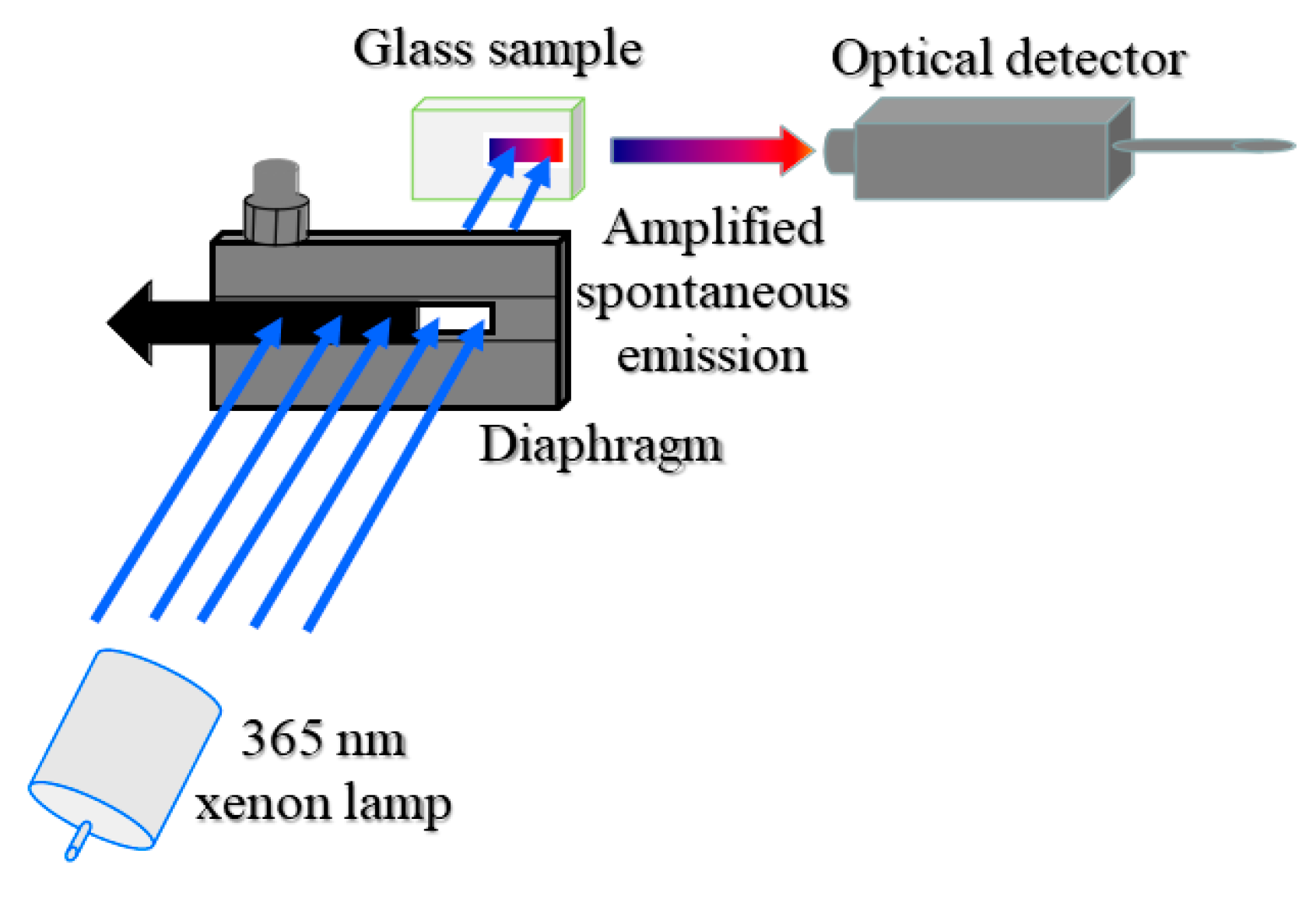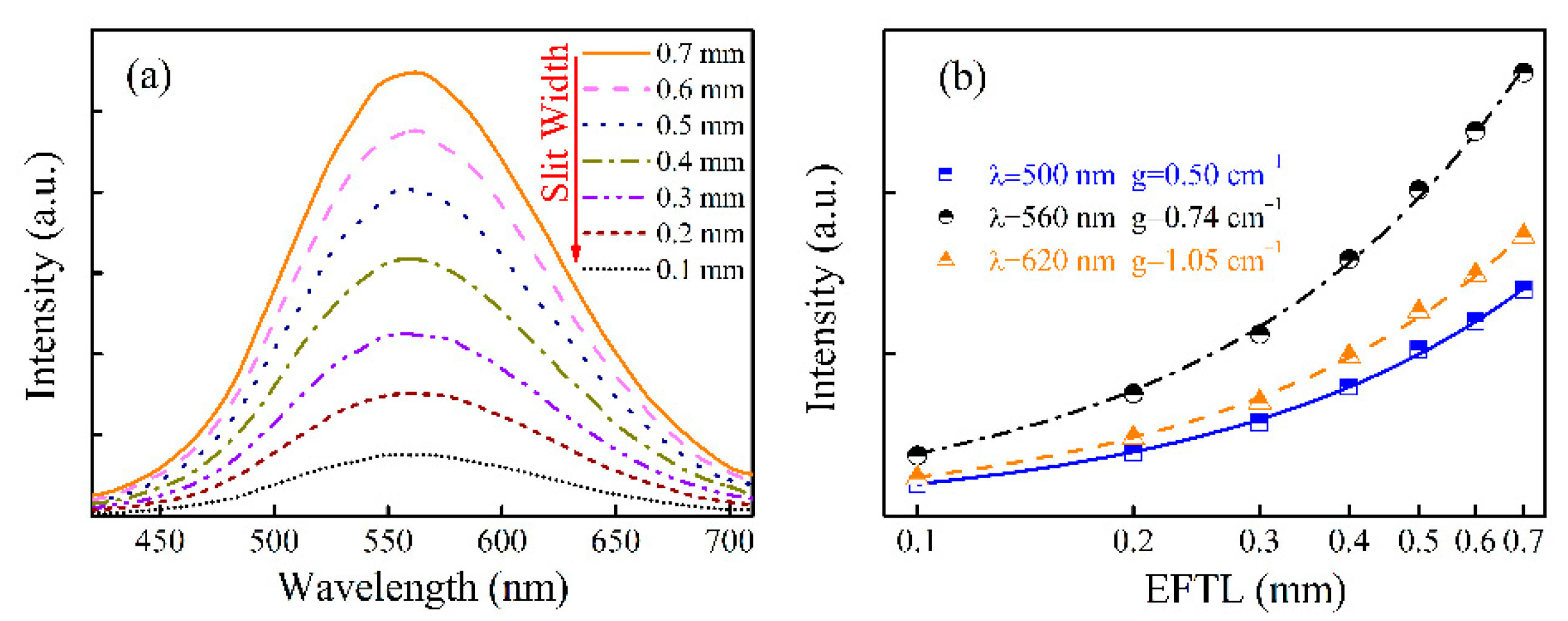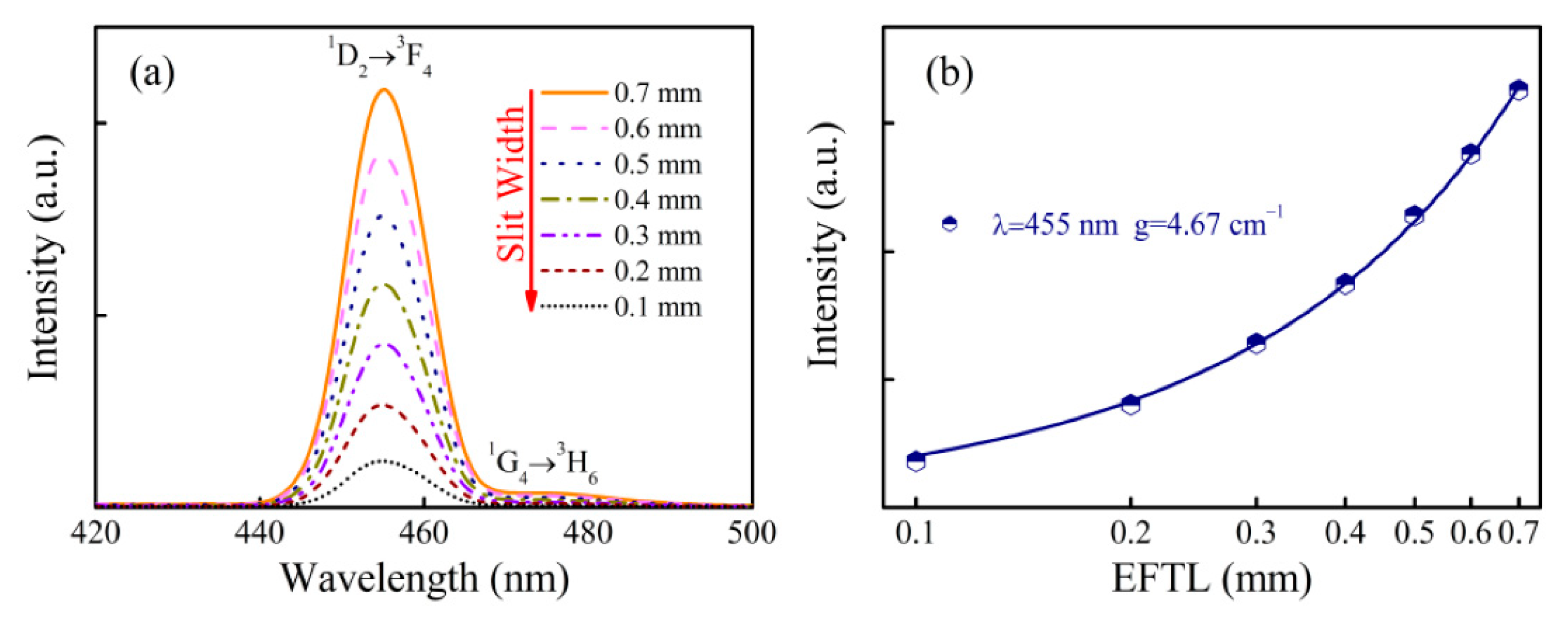Net Optical Gain Coefficients of Cu+ and Tm3+ Single-Doped and Co-Doped Germanate Glasses
Abstract
:1. Introduction
2. Experiments
2.1. Materials and Synthesis
2.2. ASE Measurement
3. Results and Discussion
3.1. Optical Gain of Cu+ Single-Doped Germanate Glass
3.2. Optical Gain of Tm3+ Single-Doped Germanate Glass
3.3. Optical Gain of Cu+ and Tm3+ Co-Doped Germanate Glass
4. Conclusions
Author Contributions
Funding
Institutional Review Board Statement
Informed Consent Statement
Data Availability Statement
Conflicts of Interest
References
- Ra, Y.H.; Rashid, R.T.; Liu, X.; Sadaf, S.M.; Mashooq, K.; Mi, Z. An electrically pumped surface-emitting semiconductor green laser. Sci. Adv. 2020, 6, eaav7523. [Google Scholar] [CrossRef] [Green Version]
- Ma, P.J.; Liu, A.J.; Dong, F.X.; Wang, M.J.; Zheng, W.H. Single-mode semiconductor lasers fabricated by standard photolithography for direct modulation. Opt. Express 2019, 27, 5502–5511. [Google Scholar] [CrossRef]
- Tournie, E.; Baranov, A.N. Mid-infrared semiconductor lasers: A review. Semiconduct. Semimet. 2012, 86, 183–226. [Google Scholar]
- Li, X.; Cao, J.K.; Huang, M.K.; Peng, M.Y. Modulating broadband near infrared emission from Bi doped borate laser glass by codoping nonactive rare earth ions. J. Non-Cryst. Solids 2021, 553, 120477. [Google Scholar] [CrossRef]
- Liu, L.L.; Li, Y.; Li, X. A broadband tunable laser design based on the distributed Moiré-grating reflector. Opt. Commun. 2020, 458, 124810. [Google Scholar] [CrossRef]
- Peng, M.Y.; Wang, C.; Chen, D.P.; Qiu, J.R.; Jiang, X.W.; Zhu, C.S. Investigations on bismuth and aluminum co-doped germanium oxide glasses for ultra-broadband optical amplification. J. Non-Cryst. Solids 2005, 351, 2388–2393. [Google Scholar] [CrossRef]
- Zhong, H.; Chen, B.J.; Fu, S.B.; Li, X.P.; Zhang, J.S.; Xu, S.; Zhang, Y.Q.; Tong, L.L.; Sui, G.Z.; Xia, H.P. Broadband emission and flat optical gain glass containing Ag aggregates for tunable laser. J. Am. Ceram. Soc. 2019, 102, 1150–1156. [Google Scholar] [CrossRef]
- Cai, Q.S.; Zhou, F.L.; Yang, N.; Xu, H.Y.; Baccaro, S.; Cemmi, A.; Falconieri, M.; Chen, G.R. Enhanced and shortened Mn2+ emissions by Cu+ co-doping in borosilicate glasses for W-LEDs. Opt. Mater. Express 2015, 5, 51–58. [Google Scholar] [CrossRef]
- Wei, R.F.; Ma, C.G.; Wei, Y.L.; Gao, J.Y.; Guo, H. Tunable white luminescence and energy transfer in novel Cu+, Sm3+ co-doped borosilicate glasses for W-LEDs. Opt. Express 2012, 20, 29743–29750. [Google Scholar] [CrossRef]
- Wen, H.L.; Xie, S.J.; Cui, J.T.; Mao, S.L.; Luo, L.; Mikhail, G.B. Optical properties of 3d transition metal ion-doped aluminophosphate glasses. J. Lumin. 2019, 213, 263–272. [Google Scholar] [CrossRef]
- Saheb, S.M.; Rao, P.V.; Vijay, R.; Babu, P.R.; Chandrakala, C.; Prasad, P.S.; Raju, G.N. Spectroscopic and electrical investigations of copper ions in PbO-GeO2 glasses. Results Phys. 2018, 11, 780–786. [Google Scholar] [CrossRef]
- Zhang, Y.H.; Chen, B.J.; Zhang, X.Z.; Li, X.P.; Zhang, J.S.; Xu, S.; Wang, X.; Zhang, Y.Q.; Wang, L.; Li, D.S.; et al. Full color white light, temperature self-monitor, and thermochromatic effect of Cu+ and Tm3+ codoped germanate glasses. J. Am. Ceram. Soc. 2021, 104, 350–360. [Google Scholar] [CrossRef]
- Rajagukguk, J.; Situmorang, R.; Djamal, M.; Rajaramakrishna, R.; Kaewkhao, J.; Minh, P.H. Structural, spectroscopic and optical gain of Nd3+ doped fluorophosphate glasses for solid state laser application. J. Lumin. 2019, 216, 116738. [Google Scholar] [CrossRef]
- Fu, S.B.; Chen, B.J.; Zhang, J.S.; Li, X.P.; Zhong, H.; Tian, B.N.; Wang, Y.Z.; Sun, M.; Zhang, X.Q.; Cheng, L.H.; et al. High upconversion optical gain of Er3+-doped tellurite glass. Appl. Phys. A 2014, 115, 1329–1333. [Google Scholar] [CrossRef]
- Liu, Z.Z.; Hu, Z.P.; Zhang, Z.Y.; Du, J.; Yang, J.; Tang, X.S.; Liu, W.M.; Leng, Y.X. Two-photon pumped amplified spontaneous emission and lasing from formamidinium lead bromine nanocrystals. ACS Photonics 2019, 6, 3150–3158. [Google Scholar] [CrossRef]
- Shaklee, K.L.; Nahaory, R.E.; Leheny, R.F. Optical gain in semiconductors. J. Lumin. 1973, 7, 284–309. [Google Scholar] [CrossRef]
- Pavesi, L.; Negro, L.D.; Mazzoleni, C.; Franzo, G.; Priolo, F. Optical gain in silicon nanocrystals. Nature 2000, 408, 440–444. [Google Scholar] [CrossRef]
- Darshan, G.P.; Premkumar, H.B.; Nagabhushana, H.; Sharma, S.C.; Prashantha, S.C.; Nagaswarupa, H.P.; Daruka Prasad, B. Blue light emitting ceramic nano-pigments of Tm3+ doped YAlO3: Applications in latent finger print, anti-counterfeiting and porcelain stoneware. Dyes Pigments 2016, 131, 268–281. [Google Scholar] [CrossRef]
- Zhang, J.J.; Wang, N.; Guo, Y.Y.; Cai, M.Z.; Tian, Y.; Huang, F.F.; Xu, S.Q. Tm3+-doped lead silicate glass sensitized by Er3+ for efficient ~2 μm mid-infrared laser material. Spectrochim. Acta A 2018, 199, 65–70. [Google Scholar] [CrossRef]
- Qin, J.J.; Huang, Y.T.; Liao, T.D.; Xu, C.H.; Ke, C.Z.; Duan, Y.F. 1.9 μm laser and visible light emissions in Er3+/Tm3+ co-doped tellurite glass microspheres pumped by a broadband amplified spontaneous emission source. J. Opt. 2019, 21, 035401. [Google Scholar] [CrossRef]
- Yuan, J.; Wang, W.C.; Ye, Y.C.; Deng, T.T.; Huang, Y.Z.; Gu, S.T.; Xiao, P. 2.0 μm Ultra Broadband Emission from Tm3+/Ho3+ Co-Doped Gallium Tellurite Glasses for Broadband Light Sources and Tunable Fiber Lasers. Crystals 2021, 11, 190. [Google Scholar] [CrossRef]
- Yun, C.; Zhang, C.M.; Miao, X.L.; Li, Z.W.; Lai, S.Y.; Sang, T. Ultra-broadband 4.1 μm mid-infrared emission of Ho3+ realized by the introduction of Tm3+ and Ce3+. J. Lumin. 2021, 239, 118368. [Google Scholar] [CrossRef]
- Zhu, T.T.; Tang, G.W.; Chen, X.D.; Sun, M.; Qian, Q.; Yang, Z.M. Enhanced 1.8 μm emission in Er3+/Tm3+ co-doped lead silicate glasses under different excitations for near infrared laser. J. Rare Earth 2016, 34, 978–985. [Google Scholar] [CrossRef]




Publisher’s Note: MDPI stays neutral with regard to jurisdictional claims in published maps and institutional affiliations. |
© 2022 by the authors. Licensee MDPI, Basel, Switzerland. This article is an open access article distributed under the terms and conditions of the Creative Commons Attribution (CC BY) license (https://creativecommons.org/licenses/by/4.0/).
Share and Cite
Zhang, Y.; Chen, B.; Zhang, X.; Zhang, J.; Xu, S.; Li, X.; Wang, Y.; Cao, Y.; Li, L.; Yu, H.; et al. Net Optical Gain Coefficients of Cu+ and Tm3+ Single-Doped and Co-Doped Germanate Glasses. Materials 2022, 15, 2134. https://doi.org/10.3390/ma15062134
Zhang Y, Chen B, Zhang X, Zhang J, Xu S, Li X, Wang Y, Cao Y, Li L, Yu H, et al. Net Optical Gain Coefficients of Cu+ and Tm3+ Single-Doped and Co-Doped Germanate Glasses. Materials. 2022; 15(6):2134. https://doi.org/10.3390/ma15062134
Chicago/Turabian StyleZhang, Yuhang, Baojiu Chen, Xizhen Zhang, Jinsu Zhang, Sai Xu, Xiangping Li, Yichao Wang, Yongze Cao, Lei Li, Hongquan Yu, and et al. 2022. "Net Optical Gain Coefficients of Cu+ and Tm3+ Single-Doped and Co-Doped Germanate Glasses" Materials 15, no. 6: 2134. https://doi.org/10.3390/ma15062134




